The striped Raphael catfish is a popular freshwater aquarium fish belonging to the family Doradidae. Known for its armored body and unique ability to produce various sounds, this fish captivates many aquarists. However, keeping a striped Raphael catfish comes with some specific care requirements. In this article, we’ll delve into these unique traits and provide insights on how to create the best environment for your catfish.
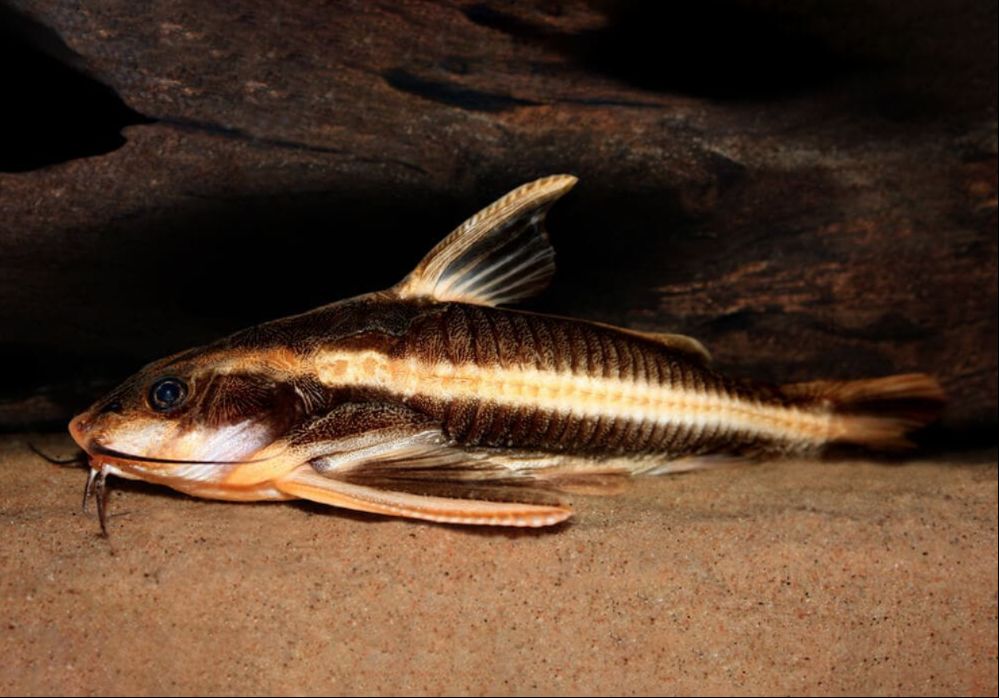
Contents
Habitat in the wild
The striped Raphael catfish, a member of the Doradidae family, is commonly known as a “thorny catfish” or “talking catfish.” These fascinating fish are primarily found in South America and are notable for their unique appearance, characterized by bony plates and spines covering their bodies.
The genus name “Platydoras” comes from the Greek words platys, meaning wide, and doras, meaning skin or armor. Initially misclassified as Platydoras costatus, this species was properly categorized as Platydoras armatulus in 2008 when scientists distinguished between two similar species.
Platydoras costatus is restricted to specific rivers in Eastern South America, while Platydoras armatulus has a much broader distribution, inhabiting the basins of the Amazon and Orinoco rivers throughout South America.
This catfish thrives in various freshwater environments, including the Orinoco river basin in Colombia and Venezuela, the Essequibo River in Guyana, and parts of the Amazon basin in Peru, Bolivia, and Brazil. It prefers slow-moving waters like tributaries, streams, and bogs, often taking refuge among submerged roots or vegetation.
Feeding primarily on mussels, crustaceans, and detritus, the striped Raphael catfish often buries itself in soft sand when threatened. During the rainy season, these fish migrate to flooded forests where food is abundant. While they can be territorial, they often form schools in the wild, enhancing their safety in numbers.
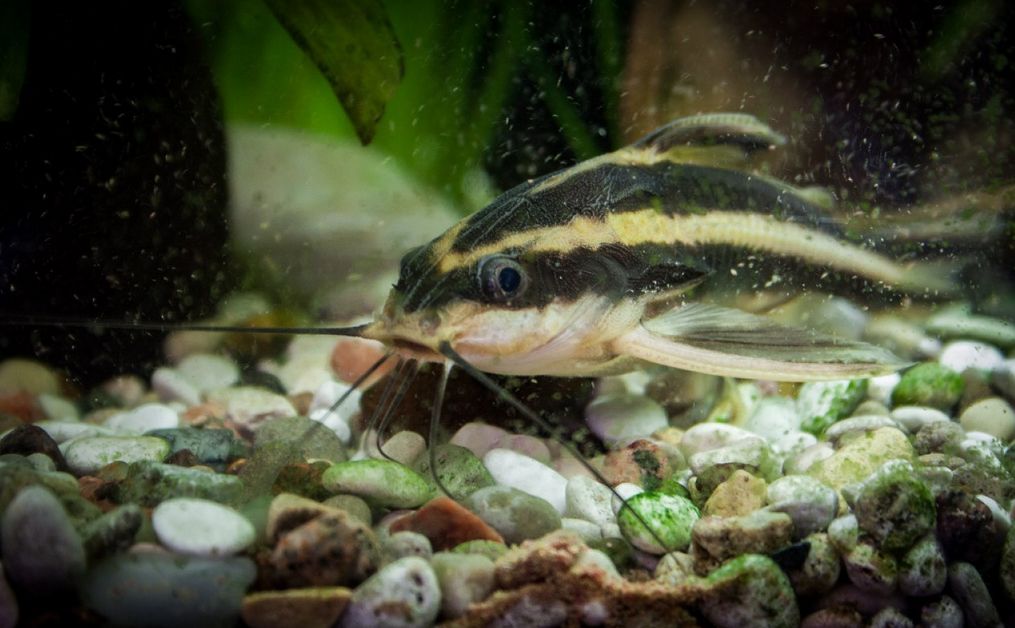
Description
Size
In the wild, the striped Raphael catfish can grow up to 20 centimeters (7.9 inches) long, with some individuals reaching even larger sizes. In captivity, adults typically measure around 15 centimeters (6 inches). Their growth can be influenced by tank size, water quality, and diet, making proper care essential for achieving their full potential.
Lifespan
These fish have a lifespan of approximately 15 years, though some records indicate they can live up to 20 years with proper care. Maintaining stable water conditions and a balanced diet can significantly impact their longevity.
Body
The striped Raphael catfish has a cylindrical, arrow-shaped body with a flattened abdomen and a prominent head. Its large, laterally spaced eyes provide excellent vision, allowing it to navigate its environment effectively. The fish features bony outgrowths that form sharp, curved spines along its lateral line, serving both as protection and a means of sensing their surroundings.
Both the dorsal and pectoral fins are notched, with the front ray of the pectoral fin covered in small spines and ending in a sharp hook. This design is crucial for defense against predators, but it requires careful handling during capture. Using a dip net can be hazardous, as its spines may get caught, potentially causing injury to both the fish and the handler.
To safely catch a striped Raphael catfish, it’s recommended to use a jar or container instead of a net, as the sharp fin rays can entangle and injure the fish. Providing ample hiding spots in the tank is also beneficial, allowing the fish to feel secure and reducing stress.
The catfish has three pairs of barbels: two central barbels on the mandible, measuring 2 to 3 centimeters long, and two longer barbels along the edges, measuring 4 to 5 centimeters. There is also one pair of longer barbels, reaching 7 to 8 centimeters, located on the maxilla. These barbels help the fish sense food and navigate in murky waters.
Young striped Raphael catfish are typically brighter in color than adults, with a body that ranges from dark brown to black and features a clear, solid lateral stripe that can be white or yellow. This pair of stripes merges into a single line on the back between the eyes, while the bottom of the head and front edges of the pectoral fins are also white. This striking coloration aids in camouflage among submerged plants and roots.
Known as “talking catfish,” they produce various sounds to communicate with others of their kind or to deter predators. They create these sounds in two ways: first, by partially blocking their pectoral fins in their cavities and rubbing their spines to produce a buzzing sound. The second method involves quickly contracting and relaxing muscles adjacent to their air bladder, creating a deeper, resonant buzz that can be heard even through tank walls or nets. This unique ability to vocalize adds an intriguing aspect to their behavior, making them captivating to observe.
| Characteristic | Description |
|---|---|
| Scientific Name | Platydoras armatulus |
| Common Name | Striped Raphael Catfish; chocolate doradid; chocolate catfish |
| Family | Doradidae |
| Origin | South America: Found in the Amazon River Basin and its tributaries |
| Size | Up to 8 inches (20 cm) in length |
| Appearance | – Striped pattern with a dark base color and light stripes |
| – Armored appearance with bony plates covering its body | |
| – Long, flowing whiskers (barbels) | |
| Behavior | – Nocturnal: Active during the night and hiding during the day |
| – Peaceful and relatively shy, tends to be a good community fish | |
| Tank Size | Preferably a large tank with ample hiding spots, at least 30 gallons (114 liters) or more |
| Water Parameters | – Temperature: 72°F to 79°F (22°C to 26°C) |
| – pH: 6.5 to 7.5 | |
| – Water hardness: Soft to moderately hard | |
| Diet | Omnivorous: Accepts a variety of foods including pellets, flakes, frozen, and live foods |
| Feeding Habits | Scavenges for leftover food and detritus at the bottom of the tank |
| Compatibility | Generally peaceful, but avoid keeping with aggressive tankmates |
| Maintenance | Regular water changes and monitoring water quality |
| Breeding | Difficult to breed in captivity, limited information available |
| Special Considerations | Be cautious of sharp spines while handling; use a net when necessary |
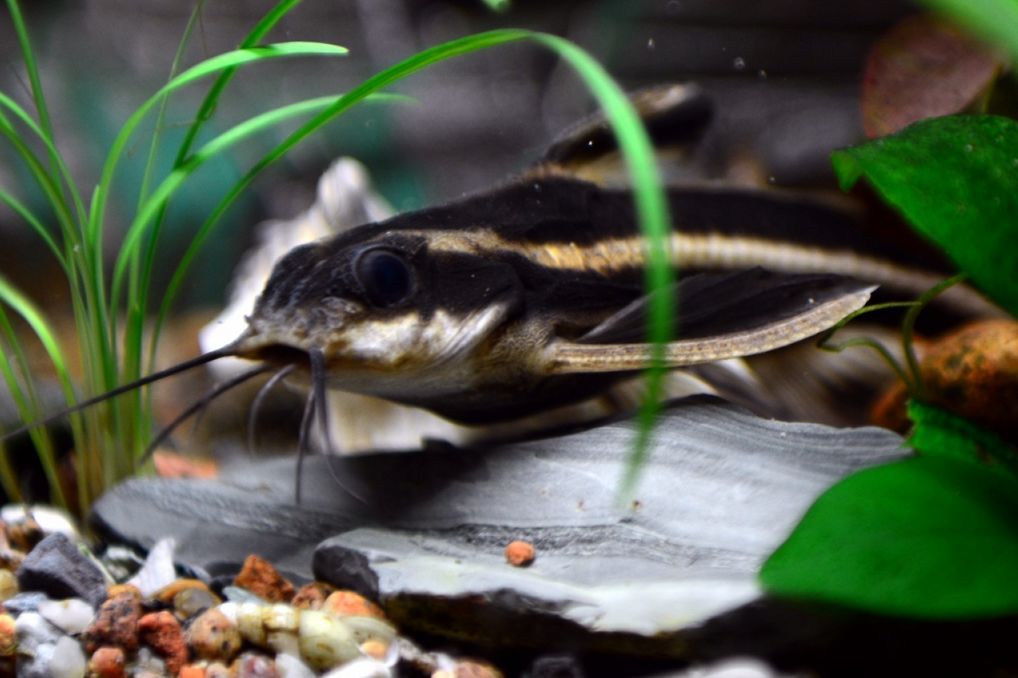
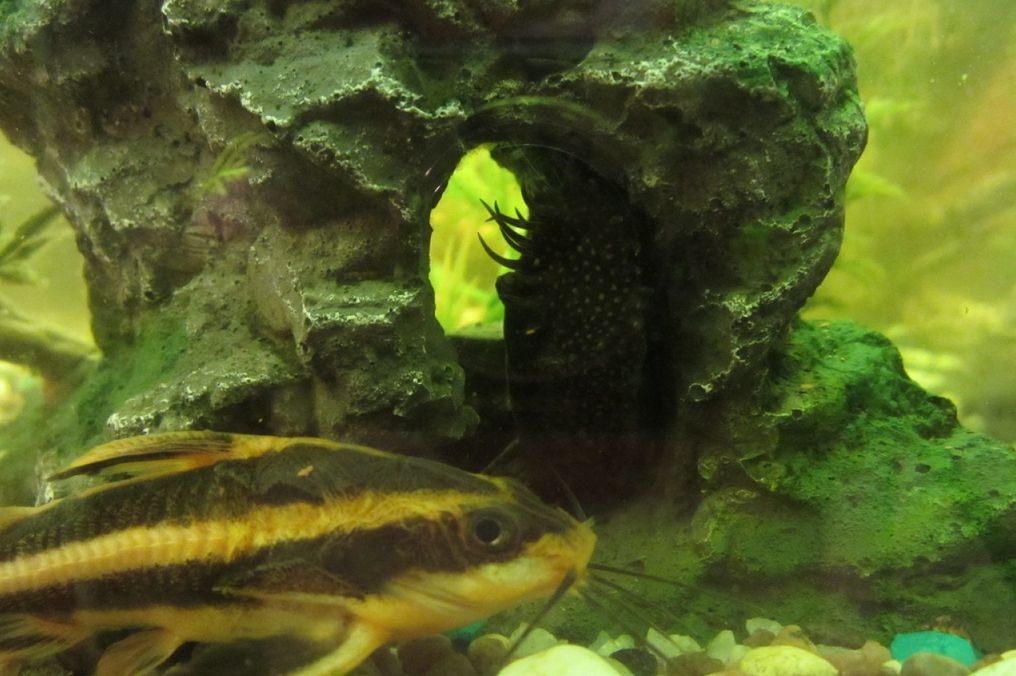
Difficulties in keeping
This renowned fish species is often considered as a perfect one for beginner aquarists. It is enduring and it can do with various range of tank conditions. However, its timid temper, the size of the adult fish and tendency to eat its smaller tank mates means that it is good only for tanks with large sized dwellers.
During the first year of the striped Raphael catfish life you can observe them whole day long. There are cases when striped Raphael catfish bobs up to the tank water surface and turns with its abdomen up – this way it gathers the food from the water surface.
As the fish grows older they become more reserved and demonstrate nocturnal habits by being more active only late at night. The fish feeds at night, correspondingly; in case if they don’t have enough food they start to eat smaller fishes in a tank.
Keeping in a tank
Tank Requirements
The striped Raphael catfish is not particularly active, but due to its potential size, it requires a tank with a capacity of at least 150 liters (33 gallons). This species can tolerate a range of environmental conditions, making it relatively hardy. Being nocturnal, it tends to be cautious and timid during the day, making it advisable to keep the tank dimly lit.
Despite its shy nature, the striped Raphael catfish often ventures out of its shelter during the day to explore its surroundings. As the fish matures, it typically becomes bolder, swimming around the tank both with the lights on and off.
This catfish enjoys burying itself in a soft substrate, so providing a sandy bottom or fine gravel is essential. Incorporating dim lighting and floating plants can help reduce light levels at the tank bottom and create a more comfortable environment. Additionally, offering various hiding spots—such as caves, flower pots, plastic tubes, driftwood, and stones—will enhance its sense of security.
While plants are not strictly necessary in the tank, they can be beneficial for reducing light penetration and providing extra shelter for the fish.
Water Parameters
The striped Raphael catfish is undemanding regarding water parameters. The ideal water temperature should range from 21 to 27 °C (70 to 81 °F), with a pH level between 6.5 and 8.0, and general hardness (dGH) between 8 and 15. Maintaining stable conditions within these ranges will contribute to the fish’s overall health and well-being.
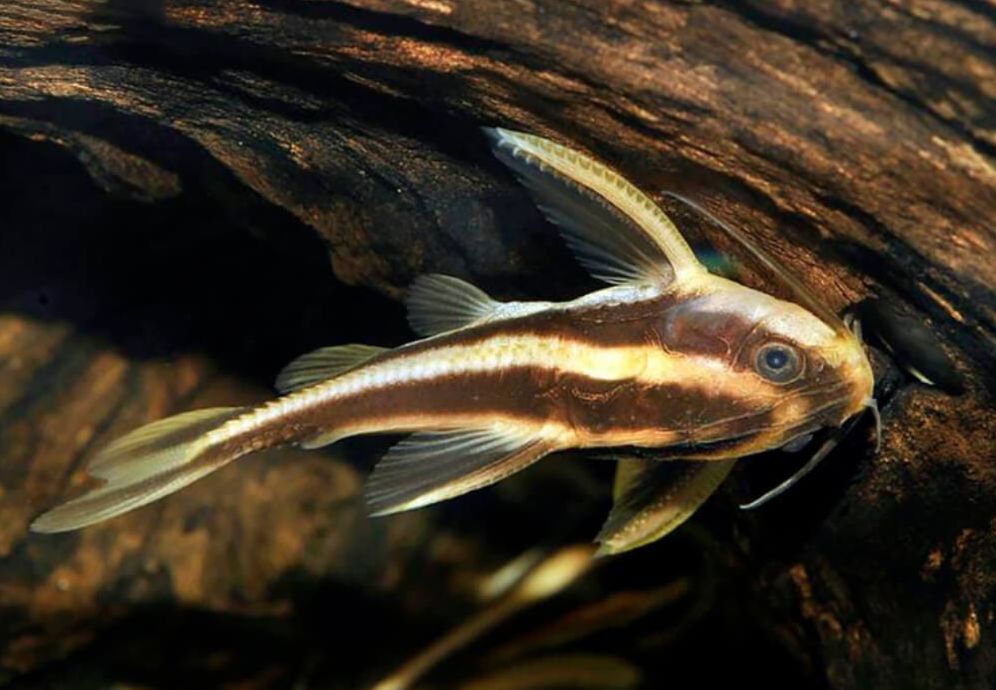
Diet
The striped Raphael catfish is omnivorous and easy to feed, making it a suitable choice for aquarists of all levels. In the wild, its diet consists of mussels, crustaceans, and detritus. As a bottom feeder, this catfish scavenges everything it can find along the river or on the tank bottom.
In captivity, the striped Raphael catfish readily accepts various types of food. High-quality pellets or tablets should form the mainstay of its diet. For supplementary nutrition, you can offer live or frozen foods such as bloodworms and small earthworms. To ensure the fish receives its food, it is advisable to feed it when the tank lights are off, as this aligns with its nocturnal nature.
Daily feeding is recommended, particularly after turning off the tank lighting, to mimic its natural feeding habits. However, be mindful of its gluttonous tendencies; overfeeding can lead to health issues. If you notice that your fish has an enlarged abdomen, refrain from feeding it for a couple of days. Generally, this swelling does not indicate illness but rather is a sign of overindulgence.
Tank mates
The striped Raphael catfish is absolutely not aggressive, but it may treat small fishes as food, that’s why they actually aren’t suitable for a community tank. They get along well with large fishes, but don’t keep them together with small sized tank mates, that they can eat (betta, guppies, platy). The fish will definitely eat them at night.
If you want to keep several species in a tank, you’ll need sufficient number of shelters for them, since otherwise they may start fighting with each other. Cichlids and other large sized fishes can be good tank mates.
Taking into account that the fish has its armor that protects it, you may even keep it with aggressive species such as flowerhorn, oscar fish, jaguar cichlid.
Gender differences: male vs female
Distinguishing between male and female striped Raphael catfish typically requires experience. Generally, males are slimmer and exhibit brighter coloration compared to females. This difference in size and color can become more pronounced as the fish mature, with males often showcasing a more vibrant hue.
Observing these subtle distinctions can help aquarists when selecting potential breeding pairs or managing their tank environment effectively. However, it’s essential to keep in mind that these traits may not be easily identifiable in younger fish.
Breeding
The striped Raphael catfish is primarily bred through hormonal injections, a method commonly used in commercial aquaculture. While there have been occasional reports of successful breeding in home aquaria, these instances are rare and often happen by accident rather than intentional efforts.
Due to their specific breeding requirements and the challenges involved, hobbyists typically do not achieve consistent success with breeding these catfish at home. This makes them more suited for aquarists focused on keeping them as pets rather than breeding.